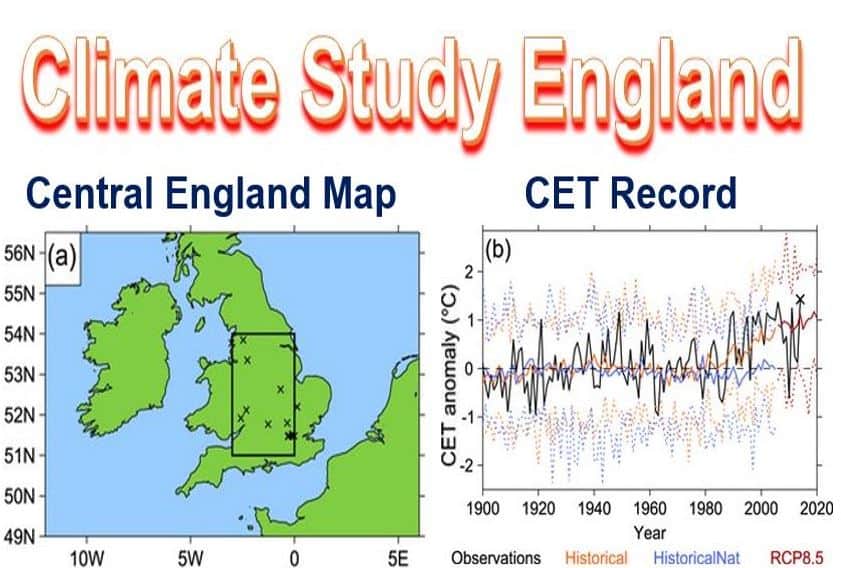Global warming is set to hit England particularly hard, with a record-breaking hot year thirteen times more likely today compared to one century ago, say Australian, Dutch and American scientists, who were surprised at how such a small geographical area could be so precisely targetted.
The researchers, who said 2014 was England’s warmest on record, wrote in the journal Environmental Research Letters that because of human-induced climate change, the country is set to have many more record-breaking hot years.
Team leader, Dr. Andrew King and colleagues reached their conclusion after examining a series of climate model simulations from data obtained from the CET (Central England Temperature) record, the oldest climate database in the world, dating back to 1659.

(a) Map showing Central England, and (b) CET records showing historical and predicted temperatures. (Image: cdn.iopscience.com)
Comparing small and large geographical areas
Dr. King said:
“When you look at average annual temperatures over larger regions of the world, such as the whole of Europe, there is a lower variability in temperatures from year to year compared with smaller areas.”
“As a result of this low variability, it is easier to spot anomalies. This is why larger regions tend to produce stronger attribution statements, so it is remarkable that we get such a clear anthropogenic influence on temperatures in a relatively small area across central England.”
The scientists looked at model simulations which compared the likelihood of record-warm years with just natural forcings on the weather with no impact from human activity, against what might happen when human influence and natural forces were combined.
Then they worked out what just the impact of human activity might be on the likelihood of super-hot years.
Dr. King and colleagues studied the CET data and picked out the hottest years in Central England from the records since the beginning of the last century, and plotted the data onto a graph. With this information, they were able to calculate the probability of record-breaking warm years occurring today compared to 1900.

Met Office map showing 2014 temperatures as a difference to the long term (1981-2010) average. (Image: Met Office)
Record-breaking warm years 13 times more likely today
The model-based study showed that the likelihood of a record-breaking hot year today in Central England has increased by a factor of thirteen compared to 100 years ago.
The authors wrote:
“The observation-based approach suggested at least a 22-fold increase in the probability of very warm years in the climate of today compared with the climate of a century ago (again with 90% confidence).”
Dr. King explained:
“Both of our approaches showed that there is a significant and substantial increase in the likelihood of very warm years occurring in central England.”
According to the reports, there has been rapid warming in Central England over the past sixty years, which correlates with human-activity’s impact on the climate.
According to the Met Office, for the whole of last year, the average temperature was 10.93°C, which was narrowly ahead of the previous record of 10.87 °C set in 2006.
The CET database is the world’s oldest instrument series of temperatures, with average monthly and daily recordings dating back to 1659 and 1772 respectively.
The CET covers a triangular area in the English Midlands, enclosed by Bristol in the south-west, London in the south-east and Lancashire in the north.
The records have undergone extensive quality control, making them an ideal resource for studies on long-term climate trends across the region.
Rest of UK likely to be super-hot too
So, is it just Central England, or also the rest of the country that will be having record-breaking warm years?
Dr. King said:
“I would expect that other areas near the UK would produce similar results.”
“For larger regions, stronger attribution statements can often be made. For example, we performed a similar attribution study for Europe as a whole and found a 35-fold increase in the likelihood of extremely warm years using model simulations.”
